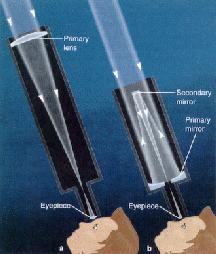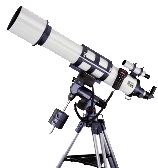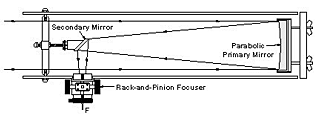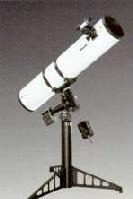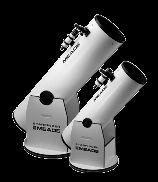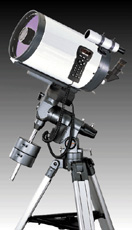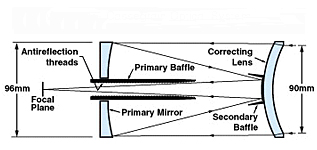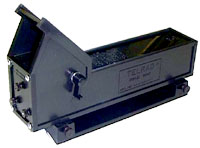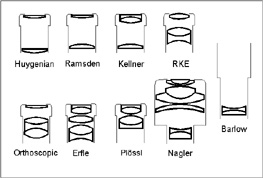Advice on buying and using telescopes
A word of warning
Astronomical telescopes often come into the category of "try a few times and then never touch again". This is because thay are often bought rather hastily and it is not realised what they are capable of achieving. They will not, in general, provide you with the wonderful images that you see in the magazines - often taken by spacecraft or the Hubble Space Telescope which do not have to contend with the blurring effects of the Earth's atmosphere. However they will, with little effort, show you rich detail on the Moon's surface, the 4 larger moons of Jupiter together with its surface detail and the rings of Saturn. With a little more effort and a knowledge of the sky, galaxies and star clusters can be seen too - the objects in the Messier catalogue, for example. The joy of using one is the fact that you are seeing these objects with your own eyes - even if you could instantly get better images from the web. It really is very worthwhile, but like most hobbies it take a little effort to get the most out of it. The best advice to give before buying a telescope is to join your local astronomical society. These often have telescopes for use by the members and observing evenings where you can look through many different types of telescope to help you make a choice of one of your own.
Why use Telescopes?
For two reasons - seeing fainter objects and to give magnified images. Many people think that the magnification of a telescope is what matters. This is not the case - rarely is it worth using a magnification more than about 150 times as the atmospheric seeing limits what is generally useable. High magnifications are then only really useful when observing small bright objects such as the planets. More important is the objective size of the telescope (lens or mirror) which determines how much light is collected so enabling one to see objects not visible by eye or by using binoculars.
Focal Ratio
The ratio of the focal length to aperture is called the "focal ratio". For example a refractor with a objective diameter of 150mm and a focal length of 1200mm would have an "f-ratio" of 8. Lower f-ratio telescopes (4-6) will give brighter, wider field views of the sky, but image quality may be a little lower in quality than longer f-ratios. Higher f-ratio telescopes (8-10) tend to be better for the Moon and planets. A focal ratio of 8 is a very good compromise.What you need to know
Lets look at size and magnification in more detail and then briefly describe the main types of telescopes that it is possible to buy indicating their strengths and weaknesses.Lens or Mirror size
The amount of light collected by a lens or mirror increases as the square of the diameter. As it is more expensive to make large lenses, refracting telescopes usually have objectives that range from 3 to 6 inchs in diameter with 4 inchs being perhaps the most common. Reflecting telescopes range from 4.5 inches upwards with 8 inches being perhaps the most common size in use by amateurs. But mirror sizes up to 16 inches are often used - but then the telescope become heavy and somewhat unwieldy.
A bigger lens or mirror allows you to see fainter objects so a view of the milky way will show myriads of stars and you may be able to see structure in deep sky objects such as galaxies and nebulae. But this does come at a price, both in the initial cost, but also in the portability of the telescope. A big telescope that is rarely used because it is heavy and unwieldy is not a good buy! For the Moon and Planets a 4 inch refractor or 6 inch reflector would be fine. For deep sky observations an 8 inch reflector would be excellent - a good light grasp without being too unwieldy.
Magnification
This is determined by the focal length of the telescope divided by the focal length of the eyepiece. A typical telescope focal length is 1000mm and a useful eyepiece focal length - at the top end of the focal length range - is 26mm. This would thus give a magnification of 1000/26 = 38. Eyepieces are available with focal lengths down to 6mm or so so you could have a magnification of 1000/6 = 166. Higher magnifications are possible using a Barlow Lens (see under eyepieces) but it is rare that the atmosphere is steady enough to allow such magnifications to be used. When observing a planet - when high magnifcations are most often used - gradually increase the magnification until no more detail is seen. It will often be not much more than x100. The diameter of the lens or mirror also puts a limit on the amount of detail possible and as a general rule a magnification of around x50 for each inch of diameter is the most that should be used - and then only under optimum sky conditions.
Telescope Types
Refracting telescopes
These are now having a resurgance in popularity as a result of the availability of generally well made Chinese refractors in the 4 to 6 inch aperture range. They are particularly suited to Lunar and Planetary viewing where aperture size is not needed. The cheaper refractors have two element objectives and suffer from Chromatic Abberation which causes some false colour around the edges of bright objects such as the Moon and Venus. It is not a problem when the telescope is used at low power for wide field sky views. Much of this false colour halo is made up of purple colour. As one gets older the eye becomes less sensitive to the read and blue ends of the spectrum that make it up so the problem is less. It is also possible to use a filter which filters out the purple colour. This can be a help too. The lower the "f ratio" the worse this problem - an f6 refractor will suffer more than an f8 or f10. An f15 refractor is barely troubled by it - but will be rather long! At some considerable expense one can buy premium refractors which usually have lenses made of three elements using special (and expensive) glass. These are termed apocromatic and can give the most exquisite views of the Moon and Planets of any telescope. You might require a mortgage though! However, in recent years the Chinese have been producing very high quality refractors at more reasonable prices and it is possible to buy "Skywatcher" Apochromatic refractors for under 800 pounds for a 4" refractor and 1200 pounds for a 5 inch model. 80mm aperture "semi-apo" refractors have become very popular and can be bought for 300 pounds or so. These will usually say that "ED" (this stands for extra-dispersive) glass has been used in the lens.
Spotting Scopes
It is possible to buy telescopes that give a true (not inverted) image that are widely used by bird watchers and called "spotting scopes" with apertures from 60mm to 100mm they can also be used for observing the sky. The "Acuter" range comes with simple achromat lenses or, at greater cost, a "semi-apo" lens using ED glass. The author has an 80mm ED Acuter spotting scope that gives excellent images of the Moon and planets. There is one thing to note: most come with a "zoom" eyepiece. These are optically fine, but give a very small field of view at the lowest magnifications. It is possible, and well worth it, to buy a fixed low magnification eyepiece to use instead of the zoom eyepiece for low magnifications.Newtonian Reflectors
For many years these were the mainstay of amateur astronomy, usually of 6 or 8 inches diameter. The cadioptic types described below are now more popular, but Newtonians still give the largest apertures - and hence light gathering power - for the money. This is particularly true if they are given very simple and hence cheap "Dobsonian Mounts". One problem with the open tube is that gradually the reflecting surface gets dirty and loses its effectiveness. It will then need to be "re-aluminized", but this is not a major cost.
The telescopes is the adajacent image have a very simple alt/az mount (see under "mounting your telescope) invented by John Dobson - hence the name "Dobsonian". For visual observations they are excellent but are normally moved by hand so not suitable for astrophotography - except for the Moon. A 6inch, or even 8 inch, Dobsonian would make a superb first telescope at reasonable cost.
Cadioptric Reflectors
These have the great advantage that the light path is "folded" so that, for a given focal length that they are quite compact and thus not too heavy. The "classical" type has been the 8 inch Schmidt-Cassegrain made by Celestron and Meade. The standard Schmidt-Cassegrain can now be obtained in diameters up to 16 inches. Other more sophisticated types are also available such as Maksutov-Cassegrains which, at a higher cost, have some advantages. A recent development has been the availability of small, 90 to 125mm Maksutov-Cassegrains on computerised "goto" mounts that allow users unfamiliar with the sky to easily find their way to many objects in the sky.
A second advantage of cassegrain telescopes is that the tube is enclosed by the glass "lens" at the front of the tube assembly. This prevents the mirror becoming tarnished or dirty. Due to the large secondary mirror, these telescopes give, theoretically, a slightly less contrasty image than refractors or long focal length newtonian telescopes and thus may be slightly less good for planetary observations. The actual effects are fairly small and often outweighed by other considerations.
High reflectivity mirror coatings
Many manufactures of reflecting telescopes now coat their mirrors with multi-layer coatings. This is sometimes at extra cost, but is well worth the extra. There are three advantages:1) The coatings have a far longer lifetime that the simple one or two layer coatings so the mrror will not need "re-aluminising" for many years.
2) They reflect more light so slightly fainter objects will be visible.
3) They scatter less light so the images will have higher contrast.
Finder Scopes
Unless your telescope is of the "goto" type you will need a good finder scope to locate the objects in the sky. The small 6x30 finders found on most cheaper telescopes are not really big enough. A 7x50 or 9x50 will be much better. When setting up the telescope, allign the main telescpe and the finder on a bright object so that when it is in the centre of the telescope field of view it lies under the crosswires of the finder. Then, when in use, find the object in the finder and centre it on the crosswires. You should then be able to see the object in a low power eyepiece with the main telescope. Under dark skies you will not be able to see the crosswires and so an eyepiece with an illuminated graticule is useful. This uses a red led to illuminate the crosswires from the side.
You can also buy some finders which have no magnification these, such as the Telrad, appear to project a red spot onto the sky and you simply place this over the object. This is fine for brighter objects but you may well need a normal finder as well to home in onto fainter objects.
Eyepieces
These allow you to vary the magnification. A very good "value for money" type for those starting out are "Plossls". A good telescope may have one or more of these as part of the outfit. A useful set of focal lengths would be 26mm, 17mm and 10mm. In addition a x2 "Barlow Lens" can be bought which will double the magnification giving, in the case here, the effect of having additional eyepieces of 13mm, 8.5mm and 5mm. The typical cost for these is about 50 - 70 pounds each. "Orthoscopics" can give fine images too. More expensive eyepieces, such as the Nagler, give very wide fields of view at high magnification. These are wonderful to use, but very expensive! Some "less expensive" telescopes have eyepieces with a barrel size of 0.96 inches. These can limit the field of view and it is better to have a telescope with 1.25 inch eyepieces.
Mounting your telescope
The mount on which you telescope is attached is vitally important. If it is too flimsy to support the tube assembly properly - and many are - you will find that each time you move the telescope it will take many seconds to stop vibrating and there will be similar problems if it is windy. Mounted on the tripod there will be a method of being able to point the telescope to any part of the sky. This could be a simple up - down, left right mounting called an alt-az mount - fine for beginners, or a more sophisticated equatorial mount that will make it easier to "track" the object across the sky. These can be equipped with quartz controlled drive motors to allow automatic tracking and fine control. The latest "goto" computer controlled telecopes tend to come with an alt-az mount. The general rule is that the beafier the mount and tripod the nicer will be the use of the telescope.
What should I buy?
It all depends on what you want to do. For beginners, a 4 inch refractor (usually with an equatorial mount) or 6 inch newtonian on a dobsonian mount provide the best views on a limited budget - say up to 500 pounds. Above this, a 4 or 5 inch computerised Cassegrain-Maksutov would be a good buy. For a similar sum, those keen on the Moon and Planets would find a 6 inch refractor good (but bulky) or, if galaxies and deep sky objects were of more interest, an 8 or 10 inch dobsonian might do well.
If you are not really sure what is best for you but must go out and buy a scope right now, the computerised Cassegrain-Maksutovs are unlikely to dissapoint and will command a good resale price if you choose to upgrade at some later time.
The number of small telescopes on computerised mounts has markedly increased in recent years and one very good buy is the 130 mm Newtonian made by Celestron called the SLT 130. It has a very nice way of setting up the mount called "skyalign" which is good for beginners. A review of this telescope can be found on this website.
Buying Second hand
Telescopes do not really wear out, so can make very good second hand buys at a great cost saving. The "Astronomy Now" magazine has over a page of advertisments each month.
Visit one of the many shops selling telescopes and ask for advice. "Astronomy Now" includes advertisments for all the telescope outlets in the UK. Find one near you and pay a visit.


